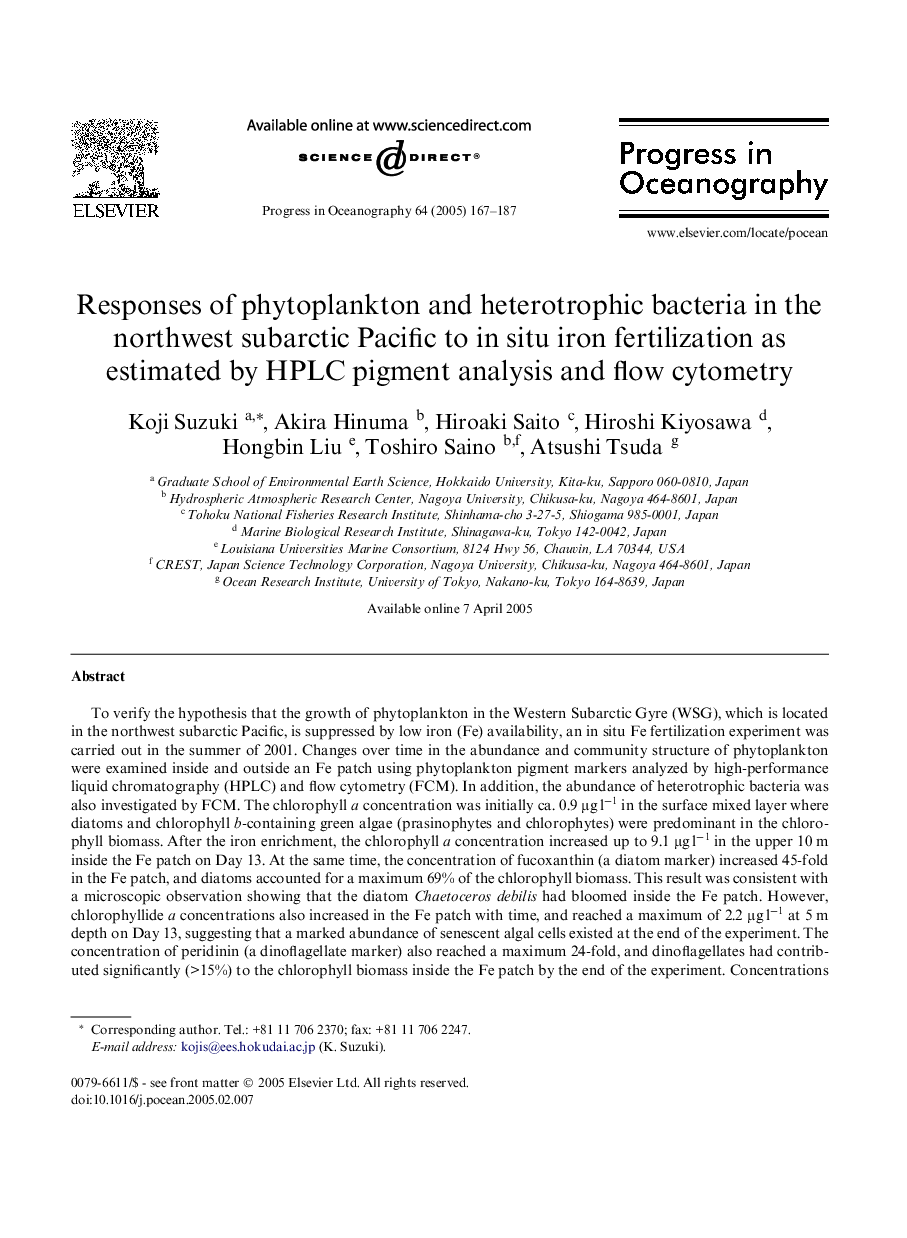| کد مقاله | کد نشریه | سال انتشار | مقاله انگلیسی | نسخه تمام متن |
|---|---|---|---|---|
| 9485109 | 1627982 | 2005 | 21 صفحه PDF | دانلود رایگان |
عنوان انگلیسی مقاله ISI
Responses of phytoplankton and heterotrophic bacteria in the northwest subarctic Pacific to in situ iron fertilization as estimated by HPLC pigment analysis and flow cytometry
دانلود مقاله + سفارش ترجمه
دانلود مقاله ISI انگلیسی
رایگان برای ایرانیان
کلمات کلیدی
موضوعات مرتبط
مهندسی و علوم پایه
علوم زمین و سیارات
زمین شناسی
پیش نمایش صفحه اول مقاله

چکیده انگلیسی
To verify the hypothesis that the growth of phytoplankton in the Western Subarctic Gyre (WSG), which is located in the northwest subarctic Pacific, is suppressed by low iron (Fe) availability, an in situ Fe fertilization experiment was carried out in the summer of 2001. Changes over time in the abundance and community structure of phytoplankton were examined inside and outside an Fe patch using phytoplankton pigment markers analyzed by high-performance liquid chromatography (HPLC) and flow cytometry (FCM). In addition, the abundance of heterotrophic bacteria was also investigated by FCM. The chlorophyll a concentration was initially ca. 0.9 μg lâ1 in the surface mixed layer where diatoms and chlorophyll b-containing green algae (prasinophytes and chlorophytes) were predominant in the chlorophyll biomass. After the iron enrichment, the chlorophyll a concentration increased up to 9.1 μg lâ1 in the upper 10 m inside the Fe patch on Day 13. At the same time, the concentration of fucoxanthin (a diatom marker) increased 45-fold in the Fe patch, and diatoms accounted for a maximum 69% of the chlorophyll biomass. This result was consistent with a microscopic observation showing that the diatom Chaetoceros debilis had bloomed inside the Fe patch. However, chlorophyllide a concentrations also increased in the Fe patch with time, and reached a maximum of 2.2 μg lâ1 at 5 m depth on Day 13, suggesting that a marked abundance of senescent algal cells existed at the end of the experiment. The concentration of peridinin (a dinoflagellate marker) also reached a maximum 24-fold, and dinoflagellates had contributed significantly (>15%) to the chlorophyll biomass inside the Fe patch by the end of the experiment. Concentrations of 19â²-hexanoyloxyfucoxanthin (a prymnesiophyte marker), 19â²-butanoyloxyfucoxanthin (a pelagophyte marker), and alloxanthin (a cryptophyte marker) were only incremented a few-fold increment inside the Fe patch. On the contrary, chlorophyll b concentration reduced to almost half of the initial level in the upper 10 m water column inside the Fe patch at the end of the experiment. A decrease with time in the abundance of eukaryotic ultraphytoplankton (
ناشر
Database: Elsevier - ScienceDirect (ساینس دایرکت)
Journal: Progress in Oceanography - Volume 64, Issues 2â4, FebruaryâMarch 2005, Pages 167-187
Journal: Progress in Oceanography - Volume 64, Issues 2â4, FebruaryâMarch 2005, Pages 167-187
نویسندگان
Koji Suzuki, Akira Hinuma, Hiroaki Saito, Hiroshi Kiyosawa, Hongbin Liu, Toshiro Saino, Atsushi Tsuda,